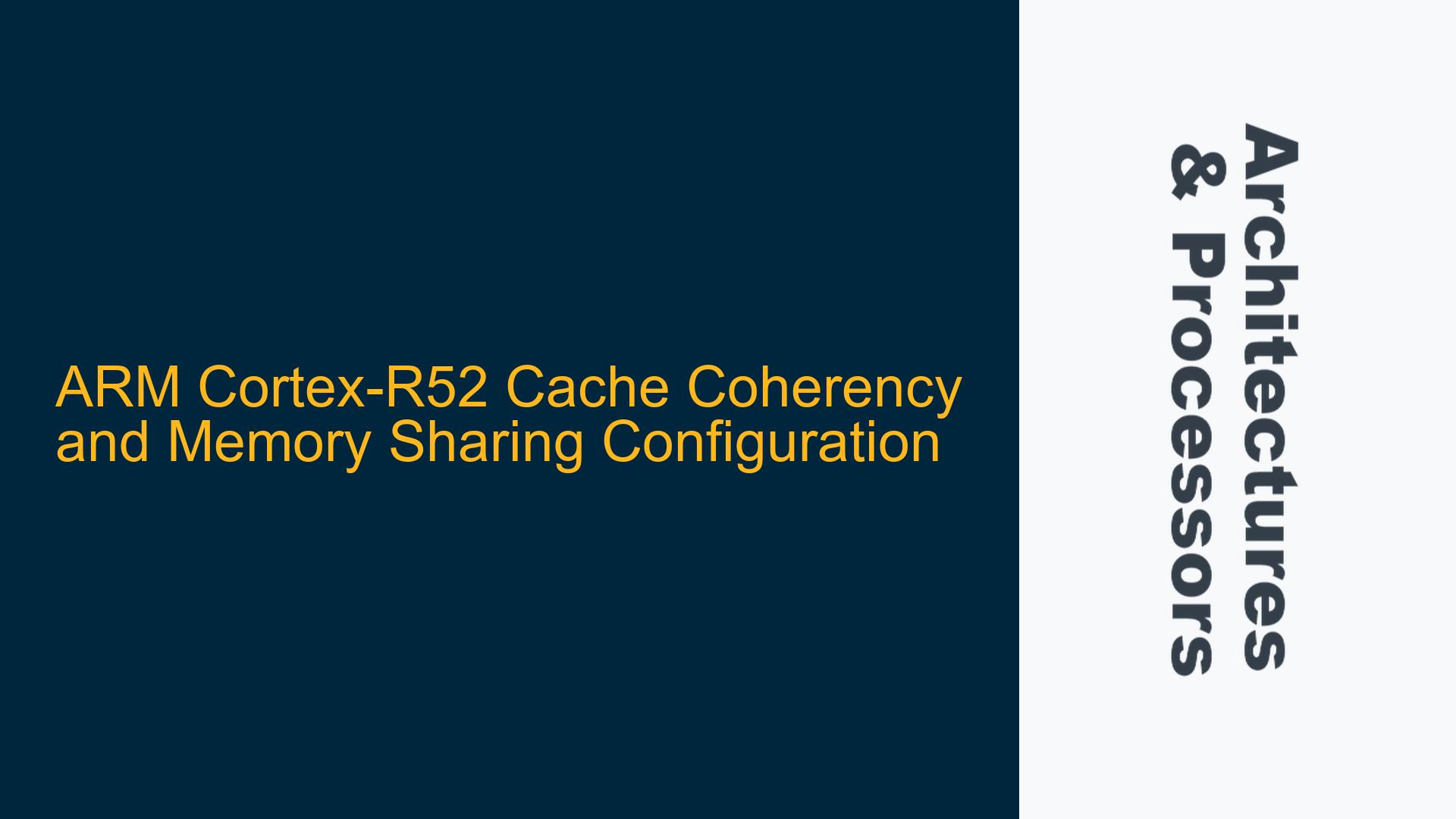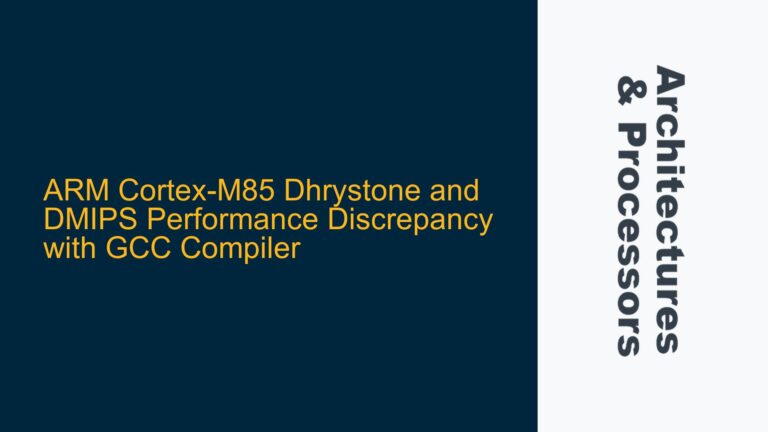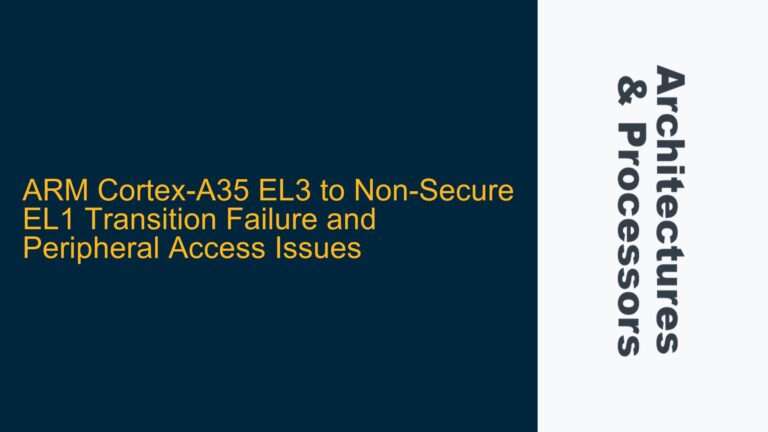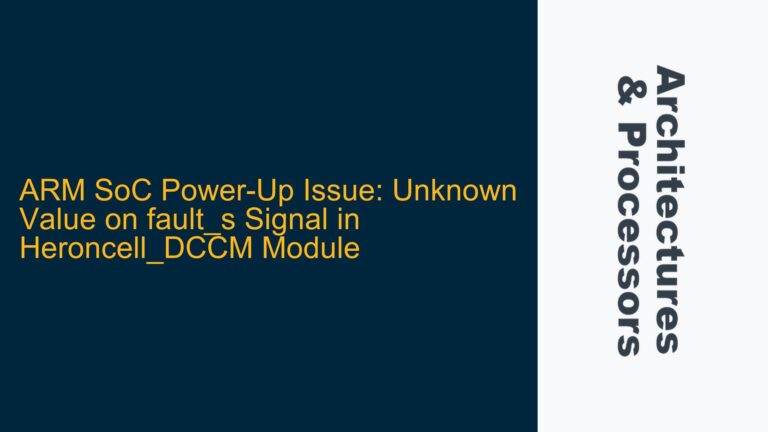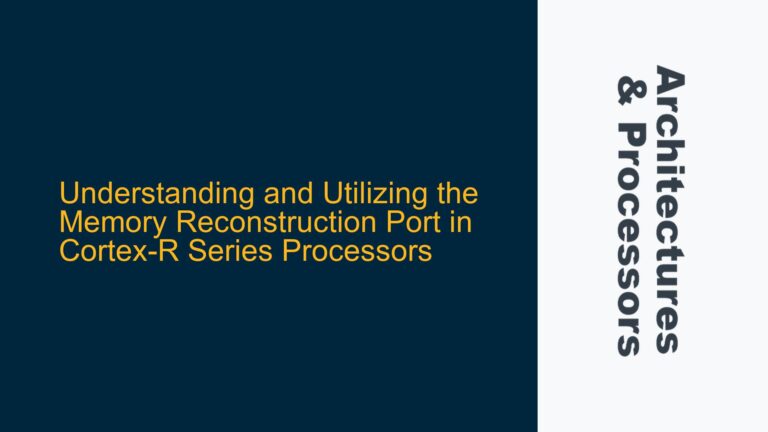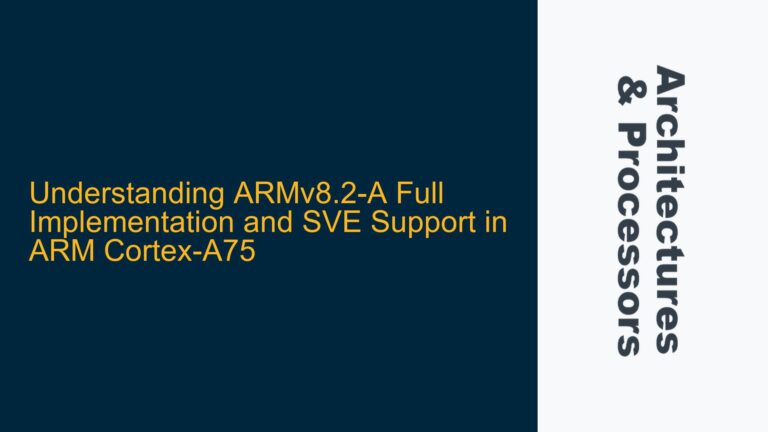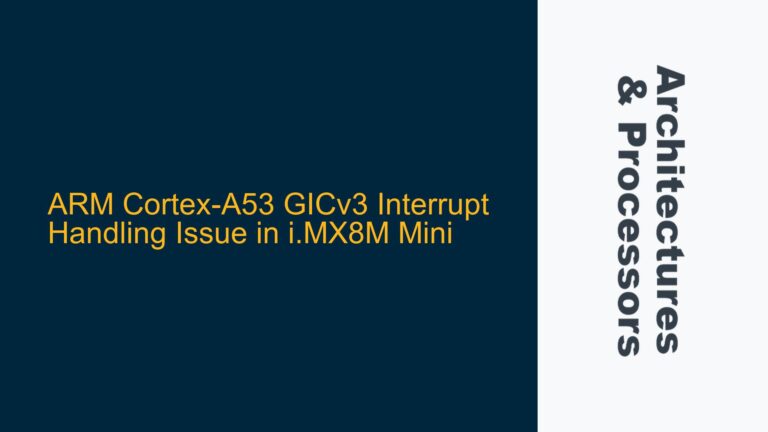ARM Cortex-R52 Cache Coherency and Memory Sharing Configuration
The ARM Cortex-R52 is a high-performance real-time processor designed for safety-critical applications. It features integrated L1 instruction and data caches, but it lacks a coherent agent, which introduces complexities when configuring memory attributes for shared memory regions. In systems with multiple clusters, cores, and external masters like DMA, understanding and correctly configuring the Inner and Outer Shareable memory attributes is critical to ensure proper data sharing and coherency across the system.
System Architecture and Memory Sharing Requirements
In the described system, the Cortex-R52 is part of a multi-cluster architecture with two clusters, each containing two cores. The system also includes external masters such as DMA controllers, which access system RAM via a system bus. The absence of a coherent agent means that cache coherency must be managed explicitly through software or hardware mechanisms. The primary question revolves around the correct configuration of Inner and Outer Shareable memory attributes to ensure that memory regions are shared appropriately between cores within the same cluster, cores across different clusters, and external masters like DMA.
The Inner Shareable attribute is intended to define memory regions that are shared among cores within the same cluster. This means that when a memory region is marked as Inner Shareable, all cores within the cluster will share the same view of that memory. This is particularly important for inter-core communication and synchronization within a cluster.
The Outer Shareable attribute, on the other hand, extends this sharing to all cores in the system, regardless of the cluster, and to external masters like DMA controllers. When a memory region is marked as Outer Shareable, it ensures that all entities in the system, including external masters, have a consistent view of the memory. This is crucial for scenarios where data needs to be shared across clusters or with external devices.
Cache Coherency Challenges in Non-Coherent Systems
In systems without a coherent agent, managing cache coherency becomes a significant challenge. The Cortex-R52’s L1 caches are not automatically coherent with external masters or even across clusters. This means that if a core modifies a cache line, the changes may not be immediately visible to other cores or external masters unless explicit cache maintenance operations are performed.
The lack of automatic coherency can lead to subtle bugs where data appears inconsistent across different parts of the system. For example, if a DMA controller reads data from a memory region that has been modified by a core but not yet written back to main memory, the DMA controller may operate on stale data. Similarly, if two cores in different clusters modify the same memory region without proper synchronization, the final state of the memory may be unpredictable.
To address these challenges, the Cortex-R52 provides mechanisms for explicit cache maintenance and memory synchronization. These mechanisms include Data Synchronization Barriers (DSB), Instruction Synchronization Barriers (ISB), and cache maintenance operations such as cache cleaning and invalidation. Proper use of these mechanisms is essential to ensure that all entities in the system have a consistent view of memory.
Configuring Inner and Outer Shareable Attributes
The configuration of Inner and Outer Shareable attributes is done through the Memory Protection Unit (MPU) or Memory Management Unit (MMU) of the Cortex-R52. The MPU/MMU allows the system to define memory regions with specific attributes, including cacheability, shareability, and access permissions.
To configure a memory region as Inner Shareable, the corresponding MPU/MMU entry must be set with the Inner Shareable attribute. This ensures that the memory region is shared among all cores within the same cluster. For example, if a memory region is used for inter-core communication within a cluster, it should be marked as Inner Shareable to ensure that all cores in the cluster see the same data.
To configure a memory region as Outer Shareable, the corresponding MPU/MMU entry must be set with the Outer Shareable attribute. This ensures that the memory region is shared among all cores in the system, as well as with external masters like DMA controllers. For example, if a memory region is used for data exchange between clusters or with external devices, it should be marked as Outer Shareable to ensure that all entities in the system have a consistent view of the data.
Cache Maintenance and Synchronization Operations
In a non-coherent system, explicit cache maintenance and synchronization operations are required to ensure that changes made by one entity are visible to others. The Cortex-R52 provides several instructions for this purpose, including Data Cache Clean (DCC), Data Cache Invalidate (DCI), and Data Cache Clean and Invalidate (DCCI). These instructions are used to ensure that cache lines are written back to main memory or invalidated as needed.
For example, if a core modifies a memory region that is shared with a DMA controller, it must perform a cache clean operation to ensure that the modified data is written back to main memory before the DMA controller accesses it. Similarly, if a DMA controller writes data to a memory region that is cached by a core, the core must perform a cache invalidate operation to ensure that it does not operate on stale data.
In addition to cache maintenance operations, the Cortex-R52 provides synchronization barriers to ensure that memory operations are completed in the correct order. The Data Synchronization Barrier (DSB) instruction ensures that all memory accesses before the barrier are completed before any memory accesses after the barrier are started. The Instruction Synchronization Barrier (ISB) instruction ensures that all instructions before the barrier are completed before any instructions after the barrier are executed.
Practical Considerations for System Design
When designing a system with the Cortex-R52, several practical considerations must be taken into account to ensure proper memory sharing and cache coherency. First, the system designer must carefully define the memory regions and their attributes based on the sharing requirements. Memory regions that are shared within a cluster should be marked as Inner Shareable, while memory regions that are shared across clusters or with external masters should be marked as Outer Shareable.
Second, the system designer must ensure that all entities in the system perform the necessary cache maintenance and synchronization operations to maintain coherency. This may require modifying the firmware or software running on the cores and the DMA controllers to include the appropriate cache maintenance and synchronization instructions.
Third, the system designer must consider the performance impact of cache maintenance and synchronization operations. These operations can introduce latency and may affect the real-time performance of the system. Therefore, it is important to minimize the frequency of these operations and optimize their placement in the code.
Example Configuration for a Multi-Cluster System
Consider a multi-cluster system with two clusters, each containing two Cortex-R52 cores, and an external DMA controller. The system has a shared memory region that is used for data exchange between the clusters and with the DMA controller. The following steps outline how to configure the memory attributes and ensure proper cache coherency:
-
Define the shared memory region in the MPU/MMU with the Outer Shareable attribute. This ensures that the memory region is shared among all cores in the system and with the DMA controller.
-
Configure the DMA controller to access the shared memory region. Ensure that the DMA controller performs cache maintenance operations if it modifies the shared memory region.
-
In the firmware running on the Cortex-R52 cores, perform cache maintenance operations before and after accessing the shared memory region. For example, if a core modifies the shared memory region, it should perform a cache clean operation to ensure that the modified data is written back to main memory. If a core reads from the shared memory region, it should perform a cache invalidate operation to ensure that it does not operate on stale data.
-
Use synchronization barriers to ensure that memory operations are completed in the correct order. For example, if a core modifies the shared memory region and then signals the DMA controller to access it, it should use a DSB instruction to ensure that the modifications are completed before the DMA controller accesses the memory.
Conclusion
Configuring memory attributes and ensuring cache coherency in a non-coherent system like the Cortex-R52 requires careful consideration of the system architecture and the sharing requirements of memory regions. By correctly configuring the Inner and Outer Shareable attributes and performing the necessary cache maintenance and synchronization operations, system designers can ensure that all entities in the system have a consistent view of memory. This is essential for the reliable operation of multi-cluster systems with external masters like DMA controllers.
